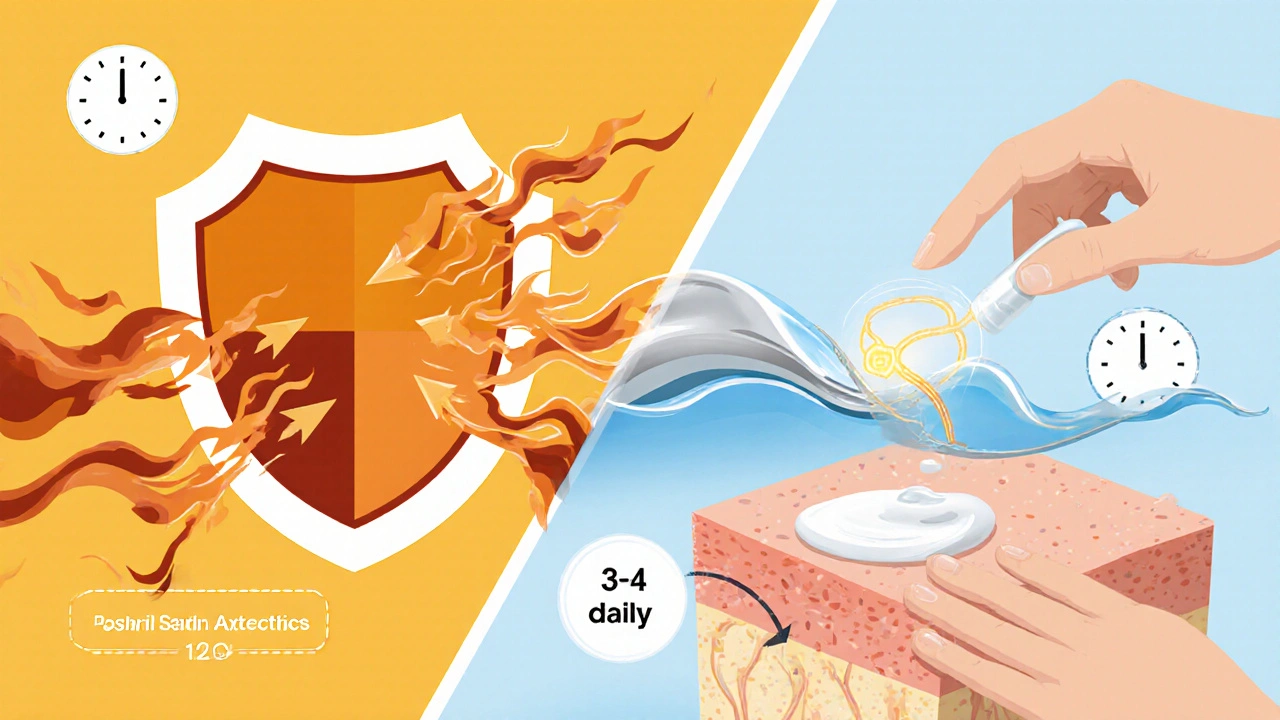Topical Pain Relief Calculator
Calculate safe application frequency and duration for Choline Salicylate Lignocaine topical pain relief based on your pain severity and usage duration.
Enter your pain severity and days of use to see safe application recommendations.
Dealing with sore muscles, joint aches, or minor sports injuries can be frustrating, especially when you want something that works quickly without a prescription. This guide breaks down everything you need to know about Choline Salicylate Lignocaine, from how it eases pain to how to use it safely.
What is Choline Salicylate Lignocaine?
Choline Salicylate Lignocaine is a topical combination drug that pairs a salicylate anti‑inflammatory (choline salicylate) with a local anesthetic (lignocaine). It’s usually supplied as a cream, gel, or spray meant for external application on skin or mucous membranes.
Topical analgesic refers to any medication applied to the skin that relieves pain without systemic effects.
How does the combination work?
The formula relies on two well‑known mechanisms:
- Choline Salicylate belongs to the NSAID family. It blocks cyclo‑oxygenase enzymes, reducing prostaglandin production, which in turn lowers inflammation and the associated pain.
- Lignocaine (also called lidocaine) is a local anesthetic. It stabilises neuronal membranes and prevents the initiation of pain signals.
When applied together, the anti‑inflammatory effect tackles swelling while the anesthetic provides rapid numbness, delivering a two‑pronged relief that many users find faster than single‑ingredient creams.
Approved uses and common indications
Regulatory agencies in the UK, EU, and many other regions have cleared this preparation for short‑term relief of:
- Muscle strains and pulls
- Joint sprains (ankle, knee, wrist)
- Minor backache caused by overuse
- Bruising and contusions
- Superficial tendonitis
It’s not intended for deep‑seated joint diseases such as osteoarthritis, nor for chronic neuropathic pain.
Dosage and application guidelines
- Wash and dry the affected area thoroughly.
- Apply a thin layer (about 1‑2mm) of the cream or gel to the skin.
- Gently massage until the product disappears - this helps absorption.
- Limit use to the recommended frequency, usually 3‑4 times per day, unless a doctor advises otherwise.
- Do not cover the area with airtight dressings (e.g., plastic wrap) unless instructed.
Most brands advise a maximum of 7days of continuous use. If symptoms persist beyond that, consult a healthcare professional.

Safety profile: side effects, contraindications and precautions
While generally safe, the medication can cause:
- Mild skin irritation or erythema (redness)
- Transient burning sensation during the first application
- Allergic reactions - rare, but possible, especially in people sensitive to salicylates or amide‑type anesthetics.
Contraindications include:
- Known hypersensitivity to salicylates, choline salts, or lignocaine.
- Open wounds, infected lesions, or severe skin conditions such as eczema or psoriasis in the target area.
- Children under 12years of age (most formulations). Pediatric use requires medical supervision.
- Pregnant or breastfeeding women - the safety data are limited, so medical advice is essential.
Special precautions:
- Patients with a history of gastric ulcers should use the product cautiously, as salicylates can aggravate gastrointestinal lining when absorbed systemically.
- Those on systemic NSAIDs, anticoagulants (e.g., warfarin), or other salicylate‑containing drugs should discuss potential additive effects with a pharmacist.
- Avoid applying to mucous membranes (eyes, mouth) unless a specifically formulated product exists.
Drug interactions and other considerations
Because the systemic absorption of choline salicylate from topical use is low, interactions are uncommon. However, be aware of:
- Concurrent oral NSAIDs - may increase overall anti‑inflammatory load.
- Systemic anticoagulants - rare increase in bleeding risk.
- Other topical anesthetics - stacking can heighten local numbness and raise toxicity risk.
If you are on multiple medications, a quick chat with a pharmacist can rule out any hidden conflicts.
Storage, shelf life and handling
Store the cream or gel at room temperature, away from direct sunlight and moisture. Keep the container tightly closed. Most products retain potency for 24months from the manufacturing date, which is printed on the label. Discard any preparation that changes colour, develops an off‑odor, or shows signs of separation.
How does it compare with other over‑the‑counter topical analgesics?
| Product | Active ingredients | Typical indications | Onset of relief | Common side effects |
|---|---|---|---|---|
| Choline Salicylate Lignocaine | Choline salicylate+Lignocaine | Strains, sprains, minor backache | 5‑10minutes | Skin irritation, mild burning |
| Diclofenac Gel | Diclofenac sodium | Arthritis, tendonitis | 15‑30minutes | Dryness, itching |
| Methyl Salicylate+Lignocaine Cream | Methyl salicylate+Lignocaine | Muscle aches, sore joints | 5‑15minutes | Strong scent, skin redness |
| Capsaicin Cream | Capsaicin (0.025‑0.075%) | Neuropathic pain, post‑herpetic neuralgia | 30‑60minutes (after repeat use) | Burning, itching |
Notice that the choline salicylate‑lignocaine mix offers a fast onset comparable to methyl‑salicylate blends but with a milder fragrance and generally lower skin irritation. Diclofenac provides anti‑inflammatory power but lacks the immediate numbing effect of lignocaine.
Key takeaways
- The combination merges an NSAID (choline salicylate) with a local anesthetic (lignocaine) for rapid, dual‑action pain relief.
- Best suited for short‑term treatment of minor strains, sprains, and superficial muscle aches.
- Apply a thin layer 3‑4 times daily, never exceed 7days without medical advice.
- Watch for skin irritation and avoid use on broken skin, open wounds, or in children under 12years.
- When compared with other OTC topicals, it delivers one of the quickest onset times while keeping side‑effects relatively mild.
Frequently Asked Questions
Can I use Choline Salicylate Lignocaine on my face?
It’s safe on facial skin provided the skin is intact and not irritated. Use only a very thin layer and avoid the eye area. If you notice redness or a burning sensation, wash it off and discontinue use.
Is it okay to combine this cream with oral ibuprofen?
Occasional use is generally fine, but both contain NSAID‑like activity, which could increase the total anti‑inflammatory load. If you need both, keep the topical use short‑term and talk to a pharmacist.
What should I do if I accidentally apply it to a large area?
Wash the area gently with lukewarm water and mild soap. If you experience prolonged burning, swelling, or systemic symptoms (e.g., dizziness), seek medical attention.
Can pregnant women use this product?
Because data on topical choline salicylate during pregnancy are limited, most guidelines advise avoiding it unless a doctor specifically recommends it.
How long does the relief typically last?
Pain relief usually lasts 3‑4hours per application, depending on the severity of the injury and individual skin absorption rates.
Armed with this information, you can decide whether Choline Salicylate Lignocaine fits your pain‑management toolbox. As always, if you’re unsure, a quick consult with a pharmacist or doctor can clear up any lingering doubts.


alex montana
October 17, 2025 AT 20:05Wow!!! This cream sounds like a miracle??!!
kendra mukhia
October 24, 2025 AT 18:45Alright, let’s dissect this so‑called “miracle cream” piece by piece.
First, the combination of choline salicylate and lignocaine is not some fringe invention; it’s been around for decades, tucked away in pharmacy shelves while the marketing hype blows up over newer “micronized” gels.
Second, the anti‑inflammatory action of the salicylate works by inhibiting COX enzymes, which is textbook pharmacology that any pharmacy student learns in the first semester.
Third, the local anesthetic component provides that numbing buzz within minutes, a fact documented in multiple peer‑reviewed studies you can actually read if you bother to open PubMed.
Fourth, the recommended dosage-three to four thin applications per day for no more than a week-is deliberately conservative to prevent systemic absorption that could irritate the stomach or interfere with blood thinners.
Fifth, the side‑effect profile is modest: occasional erythema, a fleeting burning sensation, and in rare cases an allergic reaction, all of which are clearly listed on the label for a reason.
Sixth, contraindications are not optional footnotes; applying this on broken skin or on children under twelve without supervision can lead to toxic salicylate levels, something that regulators warn about repeatedly.
Seventh, the “quick relief” claim is valid for superficial injuries, but you’ll be sorely disappointed if you expect it to cure deep‑seated osteoarthritis or neuropathic pain.
Eighth, the comparison table in the article correctly shows that diclofenac gel may take longer to onset but offers stronger anti‑inflammatory potency for chronic conditions.
Ninth, the low systemic absorption means drug‑drug interactions are rare, yet stacking with oral NSAIDs or anticoagulants is still a bad idea if you’re prone to ulcers or bleeding.
Tenth, storage instructions-room temperature, away from sunlight-are not merely bureaucratic; degradation of the active ingredients can happen faster under heat, reducing efficacy.
Eleventh, the product’s shelf life of 24 months is generous, but always check for discoloration or off‑odors, which are red flags for instability.
Twelfth, the anecdotal “face‑safe” note is accurate only for intact, non‑irritated skin, and you should scrupulously avoid the eye area.
Thirteenth, pregnant or lactating women should seek medical advice because the systemic exposure, albeit low, is insufficiently studied to rule out fetal risk.
Fourteenth, the real world usage-sports injuries, minor sprains-aligns perfectly with the intended short‑term, superficial application.
Fifteenth, if you’re looking for a “magic bullet” for chronic back pain, you’re better off consulting a physiotherapist than slathering on this cream indefinitely.
Sixteenth, in summary, this product does what it promises within its narrow therapeutic window, and the article does a decent job outlining the limits without over‑hyping it.
Bethany Torkelson
October 31, 2025 AT 16:25Listen, I’ve tried this combo on a busted ankle after a weekend hike and the numbing kicked in fast, but the lingering redness reminded me why you shouldn’t abuse it; a few days is enough, don’t turn it into a habit.
Grace Hada
November 7, 2025 AT 15:05Topical NSAIDs are fine, but overuse leads to skin barrier breakdown – respect the limits.
Nhasala Joshi
November 14, 2025 AT 13:45🤔💊 Did you know big pharma pushes this “dual‑action” cream to keep us buying overpriced patches? They hide the fact that the lignocaine can accumulate and cause systemic toxicity if you’re not careful. Stay vigilant! 🚨
Sarah Hanson
November 21, 2025 AT 12:25Thank you for bringing up the safety concerns. It’s important for everyone to read the label carefully and consult a pharmacist when in doubt, especially regarding potential systemic effects.
Rohit Sridhar
November 28, 2025 AT 11:05Great point! Using it responsibly can give that quick relief you need after a strain, and pairing it with gentle stretching can speed up recovery even more.
Wyatt Schwindt
December 5, 2025 AT 09:45Appreciate the detailed breakdown. The dosage limits are especially helpful for avoiding over‑exposure.
Lyle Mills
December 12, 2025 AT 08:25Indeed, adhering to the recommended application frequency mitigates the risk of systemic salicylate buildup, which could otherwise compromise hepatic metabolism pathways.
Barbara Grzegorzewska
December 19, 2025 AT 07:05Honestly, the whole “skin barrier” rant feels like a scare‑tactic cooked up by the anti‑cream lobby. Real athletes know a little irritation is just the price of performance.